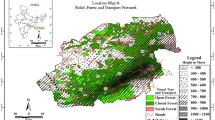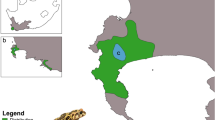Abstract
Because size reduced, or bottlenecked, populations are more prone to adverse events, the detection of genetic bottleneck signatures in wildlife species is highly relevant for conservation. Here we applied 11 microsatellite markers to the endangered Siberian tiger (Panthera tigris altaica) using tissue and blood samples of animals from the Primorsky region of the Russian Far East. Excess heterozygosity and mode shift in allele frequencies tests were positive, while the M-ratio test was negative, indicating the likelihood of a contemporary rather than a historical population bottleneck. The recent genetic population bottleneck could be attributed to the well-documented demographic collapse of the Siberian tiger population in the 1940s, when population size hit bottom with 20–30 surviving animals. The mean effective population size Ne was 14 Siberian tigers (CI95: 12–25 animals), and the effective population size/census size ratio (Ne/N ratio) was 0.028. This is the first molecular evidence of a recent Siberian tiger population bottleneck, which is of great interest for further conservation and management plans of the highly endangered largest felid species, while the worryingly low effective population size challenges the optimism for the recovery of the huge Siberian cat.
Similar content being viewed by others
Abbreviations
- N e :
-
effective population size
- CI95:
-
confidence interval at 95%
- HWE:
-
Hardy-Weinberg equilibrium
- H E :
-
expected heterozygosity
- H O :
-
observed heterozygosity
- H EQ :
-
heterozygosity at mutation-drift equilibrium
- LD:
-
linkage disequilibrium
- TPM:
-
two-phase model
- SMM:
-
stepwise mutation model
References
Broquet, T., Angelone, S., Jaquiery, J., Joly, P., Léna, J.P., Lengagne, T., Plénet, S., Luquet, E., Perrin, N., 2010. Genetic bottlenecks driven by population disconnection. Conservation Biology 24, 1596–1605.
Busch, J.D, Waser, P.M., DeWoody, J.A., 2007. Recent demographic bottlenecks are not accompanied by a genetic signature in banner-tailed kangaroo rats (Dipodomys spectabilis). Molecular Ecology 16, 2450–2462.
Carroll, C., Miquelle, D.G., 2006. Spatial viability analysis of Amurtiger Panthera tigris altaica in the Russian Far East: the role of protected areas and landscape matrix in population persistence. Journal of Applied Ecology 43, 1056–1068.
Chikhi, L., Sousa, V.C., Luisi, P., Goossens, B., Beaumont, M.A., 2010. The confounding effects of population structure, genetic diversity and the sampling scheme on the detection and quantification of population size changes. Genetics 186, 983–995.
Cristescu, R., Sherwin, W.B., Handasyde, K., Cahill, V., Cooper, D.W., 2010. Detecting bottlenecks using BOTTLENECK 1.2.02 in wild populations: the importance of the microsatellite structure. Conservation Genetics 11, 1043–1049.
Di Rienzo, A., Peterson, A.C., Garza, J.C., Valdes, A.M., Slatkin, M., Freimer, N.B., 1994. Mutational processes of simple-sequence repeat loci in human populations. Proceedings of the National Academy of Sciences 91, 3166–3170.
Garza, J.C., Williamson, E.G., 2001. Detection of reduction in population size using data from microsatellite loci. Molecular Ecology 10, 305–318.
Glaubitz, J.C., 2004. CONVERT: a user-friendly program to reformat diploid genotypic data for commonly used population genetic software packages. Molecular Ecology Notes 4, 309–310.
Handt, O., Höss, M., Krings, M., Pääbo, S., 1994. Ancient DNA-methodological challenges. Experientia 50, 524–529.
Henry, P., Miquelle, D., Sugimoto, T., Mccullough, D.R., Caccone, A., 2009. In situ population structure and ex situ representation of the endangered Amur tiger. Molecular Ecology 18, 3173–3184.
Heptner, V.G., Sludskii, A.A., 1972. Carnivora (hyaenas and cats). In: Heptner, V.G., Naumov, N.P. (Eds.), Mammals of the Soviet Union. Amerind Publishing Co., New Delhi, India, pp. 95–193.
Johnson, J.A., Dunn, P.O., Bouzat, J.L., 2007. Effects of recent population bottlenecks on reconstructing the demographic history of prairie-chickens. Molecular Ecology 16, 2203–22022.
Kalinowski, S.T., Taper, M.L., 2006. Maximum likelihood estimation of the frequency of null alleles at microsatellite loci. Conservation Genetics 7, 991–995.
Kaplanov, L.G., 1948. Tigers in Sikhote-Alin. In: Tiger, Red Deer, and Moose, Materialy k poznaniyu fauny i flory SSSR, Novaya Seria, Moscow. Izd. Mosk. Obschestva Ispytateley Prirody, pp. 18–49.
Kitchener, A.C., Dugmore, A.J., 2000. Biogeographical change in the tiger, Panthera tigris. Animal Conservation 3, 113–124.
Luikart, G., Allendorf, F.W., JCornuet, J.M., Sherwin, W.B., 1998. Distortion of allele frequency distributions provides a test for recent population bottlenecks. Heredity 89, 238–2247.
Luikart, G., Cornuet, J.M., 1998. Empirical evaluation ofa test for identifying recently bottlenecked populations from allele frequency data. Conservation Biology 12, 228–237.
Luo, S.J., Kim, J.H., Johnson, W.E., van der Walt, J., Martenson, J., Yuhki, N., Miquelle, D.G., Uphyrkina, O., Goodrich, J.M., Quigley, H.B., Tilson, R., Brady, G., Martelli, P., Subramaniam, V., McDougal, C., Hean, S., Huang, S.Q., Pan, W., Karanth, K., Sunquist, M., Smith, J.L.D., O’Brien, S.J., 2004. Phylogeography and genetic ancestry of tigers (Panthera tigris). PLoS Biology 2 (12), e442.
Luo, S.J., Johnson, W.E., Martenson, Antunes, A., Martelli, P., Uphyrkina, O., Traylor-Holzer, K., Smith, J.L.D., O’Brien, S.J., 2008. Subspecies genetic assignments of worldwide captive tigers increase conservation value of captive populations. Current Biology 18, 592–596.
Matyushkin, E.N., Pikunov, D.G., Dunishenko, Y.M., Miquelle, D.G., Nikolaev, I.G., Smirnov, E.N., Salkina, G.P., Abramov, V.K., Bazilnikov, B.I., Yudin, V.G., Korkiskho, V.G., 1999. Distribution and numbers of Amurtigers in the Russian Far East in the mid-1990s. In: Aristova, A.A. (Ed.), Rare mammal species of Russia and neighboring territories (in Russian). Russian Academy of Sciences Therological Society, Moscow, pp. 242–271.
Menotti-Raymond, M., David, V.A., Chen, Z.Q., Menotti, K.A., Sun, S., Sun, S., Schäffer, A.A., Agarwala, R., Tomlin, J.F., O’brien, S.J., Murphy, W.J., 2003. Second-generation integrated genetic linkage/radiation hybrid maps of the domestic cat (Felis catus). Journal of Heredity 94, 95–106.
Miquelle, D.G., Merrill, T., Dunishenko, Y.M., Smirnov, E.N., Quigley, H.B., Pikunov, D.G., Hornocker, M.G., 1999. A habitat protection plan for the Amur tiger: developing political and ecological criteria for a viable land-use plan. In: Seidensticker, J., Christie, S., Jackson, P. (Eds.), Riding the Tiger; Meeting the Needs of People and Wildlife in Asia. Cambridge University Press, Cambridge UK, pp. 273–295.
Miquelle, D.G., Smirnov, E.N., Salkina, G.A., Abramov, V.K., 2005. The importance of protected areas in Amur tiger conservation: a comparison of tiger and prey abundance in protected areas versus unprotected areas. Results of protection and research of the Sikhote-Alin natural landscape. In: Potikha, I.V., Miquelle, D.G., Gromyko, M.N., Pimenova, E.A., Khobtoneva, L.P., Yu Zaumyslova, O., Labetskaya, N.E., Ivanova, L.V. (Eds.), Papers Presented at the International Science and Management Conference Devoted to the 70th Anniversary of the Sikhote-Alin State Reserve. Terney, Primorksiy Region, September 20–23, 2005. Primpoligraphkombinat, Vladivostok, Russia, pp. 70–74 (in Russian with English abstract).
Miquelle, D., Darman, Y., Seryodkin, I., 2010a. Panthera tigris spp. altaica. In: IUCN 2010. IUCN Red List of Threatened Species. Version 2010.4., http://www.iucnredlist.org.
Miquelle, D.G., Goodrich, J.M., Smirnov, E.N., Stephens, P.A., Zaumyslova, O.Yu., Chapron, G., Kerley, L., Murzin, A.A., Hornocker, M.G., Quigley, H.B., 2010b. The Amur Tiger: a case study of living on the edge. In: Macdonald, D.W., Loveridge, A. (Eds.), Biology and Conservation of Wild Felids. Oxford University Press, Oxford, UK, pp. 325–339.
Miquelle, D.G., Pikunov, D.G., 2003. Status of the Amurtiger and Far Eastern leopard. In: Newell, J.P. (Ed.), The Russian Far East: A Reference Guide for Conservation and Development. Daniel and Daniel Publishers, McKinleyville, California, pp. 106–109.
Miquelle, D.G., Pikunov, D.G., Dunishenko, Y.M., Aramilev, V.V., Nikolaev, I.G., Abramov, V.K., Smirnov, E.N., Salkina, G.P., Seryodkin, I.V., Gaponov, V.V., Fomenko, P.V., Litvinov, M.N., Kostyria, A.V., Yudin, V.G., Korkishko, V.G., Murzin AA, 2007. 2005 AmurTiger Census. Cat News 46, 14–16.
Morris, W.F., Doak, D.F., 2002. Quantitative Conservation Biology. Theory and Practice of Population Viability Analysis. Sinauer Associates, Sunderland.
Oosterhout, C., Hutchinson, W.F., Wills, D.P.M., Shipley, P., 2004. MICRO-CHECKER: software for identifying and correcting geno-typing errors in microsatellite data. Molecular Ecology Notes 4, 535–538.
Palstra, F.P., Ruzzante, D.E., 2008. Genetic estimates of contemporary effective population size: what can they tell us about the importance of genetic stochasticity for wild population persistence? Molecular Ecology 17, 3428–3447.
Piry, S., Luikart, G., Cornuet, J.M., 1999. Bottleneck: a computer program for detecting recent reductions in the effective population size using allele frequency data. Journal of Heredity 90, 502–503.
Pritchard, J.K., Stephens, M., Donnelly, P., 2000. Inference of population structure using multilocus genotype data. Genetics 155, 945–959.
Raymond, M., Rousset, F., 1995. GENEPOP version 1.2: a population genetics software for exact test and ecumenicism. Journal of Heredity 86, 248–249.
Russello, M., Gladyshev, E., Miquelle, D., Caccone, A., 2004. Potential genetic consequences of a recent bottleneck in the Amur Tiger of the Russian Far East. Conservation Genetics 5, 707–713.
Sambrook, J., Fritsch, E.F., Maniatis, T, 1989. Molecular Cloning: a Laboratory Manual, 2nd ed. Cold Spring Harbor Laboratory, Cold Spring Harbor, NY.
Tallmon, D.A., Beaumont, M.A., Luikart, G.H., 2004. Effective population size estimation using approximate Bayesian computation. Genetics 167, 977–988.
Tallmon, D.A., Koyuk, A., Luikart, G.H., Beaumont, M.A., 2008. ONESAMP: a program to estimate effective population size using approximate Bayesian computation. Molecular Ecology Resources 8, 299–301.
Tilson, R., Nyhus, P., Franklin, F., 2001. Tiger restoration in Asia: ecological reality and sociological reality. In: Maher, D., Noss, R., Larkin, J. (Eds.), Large Mammal Restoration: Ecological and sociological challenges in the 21st Century. Island Press.
Wakeley, J., 1999. Nonequilibrium migration in human history. Genetics 153, 1863–1871.
Williamson-Natesan, E.G., 2005. Comparison of methods for detecting bottlenecks from microsatellite loci. Conservation Genetics 6, 551–562.
Wilting, A., Christiansen, P., Kitchener, A.C., Kemp, Y.J.M., Ambu, L., Fickel, J., 2010. Geo- graphical variation in and evolutionary history of the Sunda clouded leopard (Neofelis diardi) (Mammalia: Carnivora: Felidae) with the description of a new subspecies from Borneo. Molecular Phylogenetics and Evolution, doi:10.1016/j.ympev.2010.11.007.
Author information
Authors and Affiliations
Corresponding authors
Rights and permissions
About this article
Cite this article
Alasaad, S., Soriguer, R.C., Chelomina, G. et al. Siberian tiger’s recent population bottleneck in the Russian Far East revealed by microsatellite markers. Mamm Biol 76, 722–726 (2011). https://doi.org/10.1016/j.mambio.2011.01.011
Received:
Accepted:
Published:
Issue Date:
DOI: https://doi.org/10.1016/j.mambio.2011.01.011




